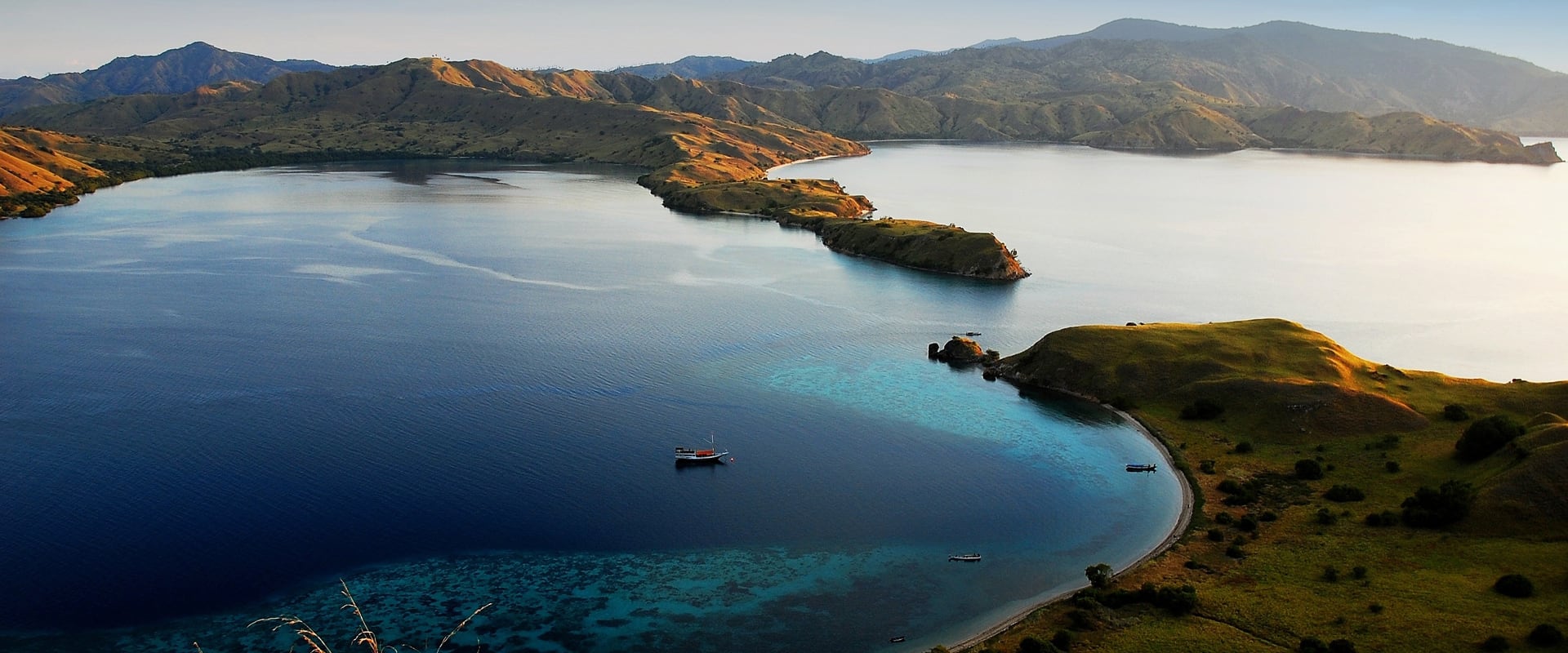Liveaboard Diving in Komodo National Park
What to expect on a Komodo National Park liveaboard
Liveaboard diving in Komodo National Park consists of itineraries to the main islands of Komodo, Rinca, Padar, and Flores along with numerous smaller islands in the Lesser Sunda Islands in the centre of the Indonesian Islands. It covers an area of 1,733 km2 more than half of which is a marine park. The park was originally designated as a protected area in 1980 to preserve its namesake inhabitants the Komodo Dragon and is now home to amazing Komodo dive cruises.
Six years later UNESCO declared the area a Biosphere and World Heritage Site in order to protect all of the unique flora and fauna living on the 29 islands in the park, to now offer some of the best liveaboard diving in Indonesia. On land, Komodo is home to several species that only live on these islands such as the rinca rat and the komodo cross frog. There are also cloud forests in the higher regions which support a range of rare fauna and many Komodo itineraries also offer land-based trips to see these amazing sights.
The terrestrial flora and fauna are however considered less plentiful that the aquatic life of Komodo. The waters around the islands are also protected by the national park with numerous mangrove forests with unique ecosystems and aquatic life. The presence of reef-building corals and abundant pelagic life also make this place unique. Mantas are frequent visitors along with mola mola, a variety of dolphins and whales and the occasional whale shark. On land and underwater Komodo is a naturalist’s paradise with fantastic topography and landscapes with sweeping bays, volcanic hills, and even a pink sand beach. Dive cruises in Komodo generally include at least an afternoon or day trip for a Komodo island tour to sneak in a Komodo Dragon sighting and see the beautiful flora and fauna.
Komodo National Park Underwater
Sailing in Komodo the waters are highly varied with beautiful stretches of shallow coral reefs, deep walls, and pinnacles, as well as current-swept volcanic mounts. The islands host a variety of different life as well. Macro lovers will find a wealth of critters such as shrimp, frogfish, and nudibranch. Being inside the coral triangle, diving in Komodo offers a wide variety of reefs that are humming with activity, it can be enough just to sit and watch the comings and goings. Komodo is home to several reef-building corals, hence its protected status.
If you are looking for something bigger then a Komodo dive cruise won’t disappoint. Mola mola are also frequent visitors to Komodo drawn by strong currents and rich waters. More occasional visitors are whales and dolphins which are attracted by the plankton-rich waters. There is even a small chance that you might see a whale shark passing by.
Mainly though, a Komodo liveaboard is the place to see mantas, in fact, if you are a little bit lucky you can even have the chance to see several mantas in one dive. The best time of year for seeing mantas is the rainy season between December and February although they are here year-round. The visibility is at its best in December and January with more than 30 meters in some areas, although the sea conditions can be a little rougher.
Guests aboard a Komodo National Park dive cruise can typically expect to do 3 - 4 dives per day, except for departure and return day. Itineraries run anywhere from 3 nights to 2 weeks, so there are dive safaris to suit everyone's budget and timeframes, and boats range from simple to high-end luxury.
Dive Sites Of Komodo National Park
A Komodo dive trip is undoubtedly the best way to experience the Komodo National park, which is blessed not only with abundant marine life but also a huge number and range of different dive sites.
BATU BALONG is one of the jewels in Komodo’s crown with the beautiful coral gardens simply humming with fish life. The strong currents and deep walls also offer the opportunity for big fish as well. Sharks and huge napoleon wrasse can be seen in these deeper waters offering photographers the chance to get some amazing shots.
MANTA ALLEY - Many divers come to Komodo to see the mantas though and there are few places better than Manta Alley. The site is relatively shallow with much of it around 10-20 meters/ 32-65 ft. allowing a nice long dive time to spend with what can be double digits of mantas and other rays. If you are lucky you might see the younger ones playing and swimming around each other.
MANTA POINT similarly offers the opportunity to dive with mantas that come to this patch to feed in the currents. This is a drift dive with some serious current and you will likely be drifting with numerous mantas as well as white-tip reef sharks, unicornfish and the small but fierce mantis shrimp.
GOLDEN PASSAGE, close to Gili Lawa Darat is also one of the signature dives of Komodo with the expected currents making it a drift dive. Divers can drift down and over the coral reef to see reef sharks and sometimes even dolphins and mantas swimming through.
Top Tips For Divers
- The local language is Indonesian although there are a great number of local dialects in Komodo.
- The currency is the Indonesian Rupiah and the predominant religion is Islam so dressing modestly during land excursions is recommended.
- The currents in Komodo can be extreme so it is important to stay with the dive leader as they will know the area and where dangerous areas with down currents are.
- The temperature of the water varies enormously between north and south so bring extra thermal protection to avoid getting cold.
Getting To Komodo National Park
The islands of Komodo National Park are very fortunately still off the beaten track for tourism. There are a huge number of dive sites and some which are quite remote making a Komodo liveaboard the best option for visiting the park. There are also day boats that leave from Labuan Bajo and can take from thirty minutes’ transit to several hours depending on the dive sites.
There are a variety of different Indonesian Liveaboards to suit different budgets and tastes. There are motor vessels available but most are the traditional phinisi, a beautiful Indonesian two-masted sailboat converted for diving. Divers can enjoy the experience of peaceful sailing and fine accommodation with purpose-built diving facilities on board.
Liveaboards either leave from Bali or Labuan Bajo which can be reached from Bali International Airport (Ngurah Rai) with regular flights to Asia and connections further afield. There is also a several day-long ferry to Labuan Bajo although this is reserved for those more adventurous travelers.
Komodo National Park Diving Reviews
- 9.4 Superb
- 9.6 Exceptional
- Susan U
United Kingdom
Great diving but can be very busy. Have done day dives and liveaboard and would recommend liveaboard for extra flexibility and early morning / night dive options
Diving Komodo National Park in October on the Moana
- 10.0 Exceptional
- Amber K
New Zealand
Very cool to see the Komodo dragons! Lovely tour guides. Also stunning viewpoints for sunsets!
Diving Komodo National Park in September on the Akomo Isseki
- 10.0 Exceptional
- JINPEI L
China
The trip to Komodo National Park to see the Komodo dragons was a real highlight as well.
Diving Komodo National Park in August on the Nusantara
- 10.0 Exceptional
- Robert L
Australia
Awesome, great to see the Komodo dragons
Diving Komodo National Park in July on the Ikan Biru
- 9.6 Exceptional
- Tessa O
Singapore
Amazing savannah landscape with diverse marine life
Diving Komodo National Park in July on the Lady Denok
- 10.0 Exceptional
- PETER B
Australia
Spectacular scenery, marine life and coral.
Diving Komodo National Park in July on the Mermaid II
- 9.6 Exceptional
- Jaime B
Spain
Stunning Marine Biodiversity The vibrant coral reefs were alive with colorful fish, manta rays gliding by, and even the majestic Komodo dragon on land. Exciting Drift Dives The currents offered thrilling drift dives, allowing us to effortlessly glide past spectacular underwater landscapes. Incredible Encounters Swimming alongside majestic manta rays and spotting sharks added an adrenaline rush to every dive. Diverse Dive Sites Each site, from Batu Bolong to Castle Rock, revealed unique underwater ecosystems, ensuring every dive was a new adventure.
Diving Komodo National Park in July on the Bajak
- 9.2 Superb
- Raimondo R
Italy
Komodo is a fantastic diving destination, there is a bit of everything: big animals such as whale sharks and mantas, macro mareen life, drift dives, beautiful coral reef.
Diving Komodo National Park in June on the Mermaid I
- 10.0 Exceptional
- Martha P
United Kingdom
Untouched and picturesque - a must do in Indonesia
Diving Komodo National Park in June on the Nusantara
- 10.0 Exceptional
- Mace B
United States
The park has a huge diversity of dive sites. From coral gardens to manta cleaning stations - so much sea life here and fairly pristine reefs in good health.
Diving Komodo National Park in May on the Sokaraja
See all liveaboards from $581 to $12,082 per trip








